Don't wanna be here? Send us removal request.
Text
Tony Cragg
Born on the 9th April 1949 in Liverpool. He studied art at Gloucestershire college of art and technology from 1968 to 1970 where he went on to paint at Wimbledon school of art, London, rom 1970 to 1973. He would move to Germany in 1977. Tony Craggs early work consisted of site specific installations that were made and inspired by found objects and old materials that were no longer used by others. One of his most iconic work is Spring made in 2015 made from bronze. Craggs concept for his work feels very trypophobic and misshapen and yet it can come together to form a coherent shape or figure. His work doesn’t imitate nature and what we look like, instead it concerns itself with why we look like we do and why we are the way we are. When making his sculptures Cragg sketches out his designs and the ways he wants his sculptures to curve and bend, then a group of carpenters carve the wood into shape, the designs are painted and polished and send out to finally be installed.
0 notes
Text
Yinka Shonibare
A British-Nigerian artist living in the UK, his work shows his struggle and push and pull of his cultural identity. He primarily uses Ankara fabrics on manikins, he can only give his ideas and sketches for his works as he has a disability that paralyses the entire left-hand side of his body. He was born on 9th of august 1962, born in England then moving to Nigeria later moving back to England when he was 17. Yinka contracted a desiese in his spine that caused inflammation resulting in the long-term disability he has now, made to use a wheelchair. One of his most iconic works of art is “party-time: re-imagine America” made in 2009 it is a site-specific installation. It depicts a late 19th century dinner party midway through a multi-corce feast. With 8 figures dressed in Dutch wax fabric that closely resembles traditional African clothing and patterns, the headless figures take away any sence of identity in them and an idea that they themselves are non-existant. Yinka’s concept of his works portrays itself as a lacking of identity, which he shows through his headless mannequins, this could be because of his move from England to Nigeria and back to England where he feels a sense of identity in both places he called home. to make his works Yinka first sketches out his ideas and chooses his favored fabrics he wants to use for his works then he passes it on to others who work with him to make and construct the final piece as he himself cannot take part in that part of the prosses, once the piece is constructed and put together he takes a final look at It with any last requests or changes then his work is finally installed and put on display.
0 notes
Text
Compare and contrast
The difference between the two artists is clear, one focuses on industrial shapes while the other turns to a more contorted and disturbing media. Bourgeois’ odd shapes and frightening sculptures show a darker side to the art world and show that art can be made to look a certain way with simple yet effective charges to a subject. Her work on the Cells showed possibly how Bourgeois felt about her home like during her early years and helped put into perspective feelings that some others may have about their home lives. Whereas Serra shows how simple something can be for it to be effective and make observers feel different emotions based on the view that they have of the sculpture. The different bends and shapes the sheets of metal make give off a calming and daunting feel, it all depends on where you stand, his work can be interpreted in many different way and that purely depends on the observer themselves.
0 notes
Text
Artist Research
Richard Serra was born November 2nd in 1938, San Francisco, California. Much like Bourgeois he was a middle child in a house of 5, his father was a Spanish native of Mallorca and his mother was a Russian Jew. In his early years he studied English Literature at the university of California, Berkeley in 1957 before eventually moving to the university of California, Santa Barbra. He would then go on to study art at yale school of art between 1961 and 1964 and took much of his inspiration for his work from different artists who taught there.
One of his most famous works would be his large steel sculptures, he would made several of these works and make them site specific, with the idea of making the observer feel small and inferior. His most famous of these installations is the Torqued Ellipse series which was first introduced in 1996 as a single elliptical form that took inspiration from Baroque church in Rome. The structures were large sheets of metal that were bent into circular shapes and leaned in or out.
Serra’s concept conveys a very industrial feel with large, tall sheets of steal the shapes he creates almost mimic skyscrapers. The dark and looming shapes give off a sinister feel as the bends in the metal create shadows that block out a lot of light when you walk under or in between them much like some streets in a busy town.
One of his works I enjoy is inside out, one of his large steal sculptures that was installed in 2013 in New York, the twisting and bending metal creates large spaces inside it as well as small and claustrophobic spaces this gives the observer a choice to walk straight into the open areas of his sculpture or to brave the narrow spaces that surround it.
0 notes
Text
Artist Research
Louise Bourgeois was born on 25th December 1911 and died 31st of March 2010. She was born in Paris, France, as a middle child in a house of 5. In her early years of life, she studied and had a passion for mathematics and science at Sorbonne, however when her mother died it inspired her to abandon mathematics and move into a different field of study. She joined different art classes and groups at Sorbonne, where another artist, Joseph Fernand Henri Léger, saw her work and expressed to her that she was a sculptor instead of a painter. She eventually graduated from Sorbonne in 1935 where she went on to study at École des Beaux-Arts and École du Louvre, while there she also visited many different studios and learned different techniques from different artists.
One of her most famous works was Maman, in the 1990s Bourgeois started using spiders as a central image in her works, making terrifying sculptures of them with crewed misshapen legs. Maman which stood more than 9 ft tall, is made from steel and marble. Multiple casts were made from this and cast in bronze. Her largest installation of Maman is over 30 feet tall, 9.1 meters. She has installations all over the world in different countries.
Bourgeois has crude concepts full of misshapen bodies and crude etchings in sculptures, her sculptures of the human body show a contorted and out of form body, some without arm and some without any shape to their figures at all. It could be said the reason she made art is propelled by her mother’s death, there could also be other unknown reasons as to why she made her sculptures and paintings.
One of her works I am interested in would be cells, she had multiple works under this name and all of them complied to the same idea of fear and confinement. Bourgeois’ works Cells, features cages with household furniture inside them, such as a table and chares or a bed. Her work on Cells shows a claustrophobic side to the places we should feel the most comfortable, our homes, and how sometimes we can begin to feel trapped inside our most happy spaces.
0 notes
Text
Celeste Boursier-Mougeuot was bird in Sete, France in 1961. He trained at the conservatory of music in Nice, he enitioly worked as a composer for avant-grade music productions. From 1985 to 1994 he was a musical director for the theatre company of Pascal Rambert, a writer, choreographer, and director.
His work is a mixture of sound and visual aspects, unexpected sources of musical sound. In one of his pieses, Clinamen, he uses a combination of water and bowls to make a mixture of sounds, the clanging of the bowls on the water sounds like wind chimes in hitting each other in the wind.
Boursier-Mougeuot uses a mixture of natural and man made elements in his work, for example in his work, From Here to Ear, Boursier-Mougeuot uses a pack of zebra finches in a room filled with let her and electric guitars to make raw loud and sharp musical sounds, mixed with the sounds of birds chirping softly in a echoed room, the guitar only making noise when the birds landed on its strings or hit the strings as they landed.
In Boursier-Mougeuot's piece Alquaalta, he brings a sencse of unknowing to the viewers in the form of a dark underground river, the visitors are invited to board boats and ride along the dark river as the water casts small amounts of light and and strange shadows along with small echoed sounds of the boats on the water, the tunnel amplifying the water as it being the only noise in the area, the limited sight, helping the sound carry further and amplifying the visitors hearing.
https://www.youtube.com/watch?v=89Kz8Nxb-Bg
https://www.youtube.com/watch?v=stFyG_AAje8
https://www.youtube.com/watch?feature=youtu.be&v=RdCutpuUrX4&app=desktop
https://www.lemonde.fr/arts/video/2015/06/23/acquaalta-l-onde-sensorielle-de-celeste-boursier-mougenot_4660256_1655012.html
0 notes
Photo

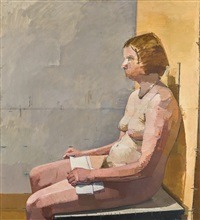
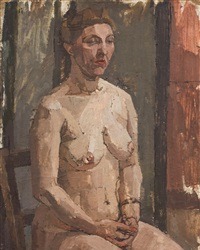

Euan Uglow
Uglow was a British painter, born on March 10th in 1932 in London. He studied at the Camberwell school of art from 1948 till 1950 he then left to follow his teacher and study at the Slade School of art in 1951, where he stayed for a further 4 years. After he finished studying he would spend two years doing community work as he refused compulsory military service, he would spend those two years helping restore a war damaged church in London. Redecorating the house of another artist, Patrick George and helping on a farm in surrey. Uglow’s success was not immediate once he left art school, he would sell his first painting eight years after he finished studying.
Uglows style mainly surrounds portraiture and human life/ figures. He creates paintings that re not hyper real but still strongly resemble the human figure in an abstract way, making them appear almost sculptural. In Uglow’s painting the standing figure, a woman is shown in as if she is walking, the figures face is blurred out taking away any sense of identity from the woman. Some of his other paintings also have the faces of figures blurred out, for example the painting seated nude the initial details of the face are still there, there is no real detail or expression on the figures face once again taking away any sense of identity. Uglow touches on still life in some of his paintings but mostly focuses on the human figure.
One of Uglows most iconic paintings is Night Scene, it depicts a woman figure who’s back is turned with what could be interpreted as their arms tied up in a mess of rope and skin. With blue covering most of the background it gives off a deep feeling of sadness as if they are trapped within themselves.
In a majority of his paintings Uglow uses small sharp brush strokes to create squares of colour that piece together to make the bigger image come together perfectly, the squares of colour make a boxy looking figure that blends together well showing the clear difference between light and dark.
3 notes
·
View notes
Photo
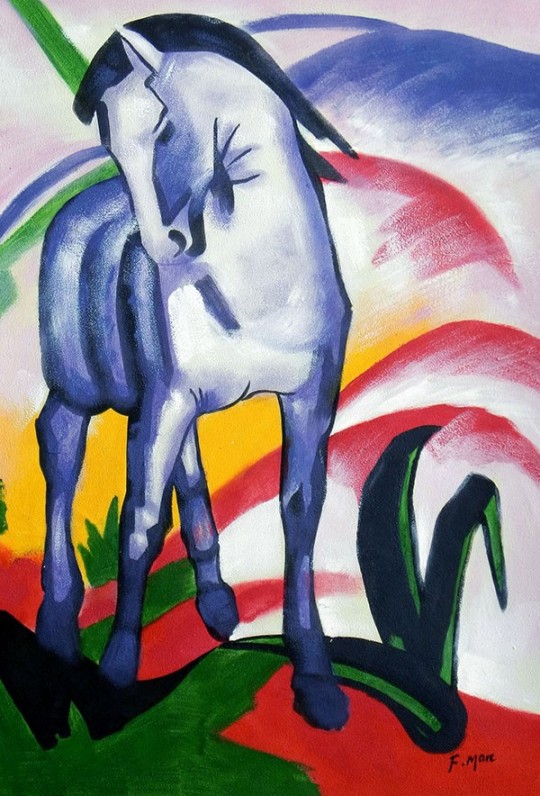
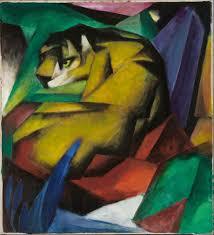
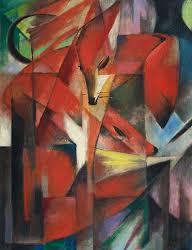
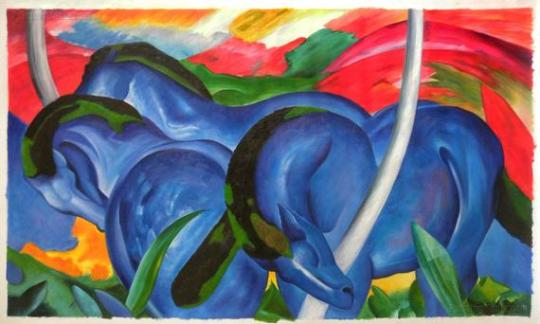
Franz Marc
Marc was born on 8th of February 1880, in Germany. He was a founding member of Der Blaue Riiter, The Blue Rider in English, a group of artists who rejected the New Association Of Artist (NAOA), as they believed there principles had become too strict and traditional. They focused on expressionism to battle against the NAOA. Marc was born into a family where art was heavily present, his father was a professional landscape painter. At the age of 17 Marc studied theology however two years later he decided to study at the arts program of Munich University but he was first required to serve in the military for a year, after which he began his studies. During 1903 and 1907 Marc spent most of his time in Paris visiting museums and copying paintings, during that time he discovered a affinity for Vincent Van Gogh and his style and command of colour.
Marc’s work mostly displays animals with a nature centred background. His work is more on the coloured side with unnatural colours such as deep and bright blue tones for horses in his painting Die Großen Blauen Pferde, which translates to the large blue horses. This particular painting also displays shades of red purple and yellows in the background behind the horses.
One of Marc’s most iconic paintings is the blue horse painted in 1911. This depicts a large blue horse against a background of red and white. The main focal point of the painting being the blue horse, the minimal detail in the rest of the painting allows the horse to hold the attention of the viewer. The soft colours and brush strokes give a kind and free feeling to the painting as if the colours were to represent a soft wind.
0 notes
Photo
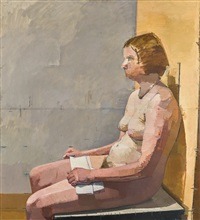
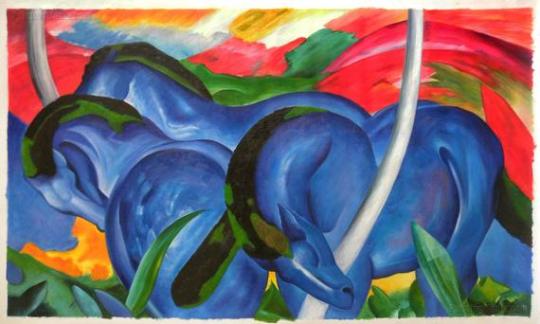
The difference in the two artists work is clear as day, Uglows consists of realism and still life where as Marc focuses on more if an abstract rout looking at animals and their habitats. Uglows colour pallet is neutral and plain looking showing natural skin tones and lights and darks, whereas Marc uses a more vibrant and colourful with mixes f blues and reds surrounded with greens and bright vibrant yellows that are shown in different shapes and areas of the canvases. Uglows pail paintings give off a soft and calm feel whereas Marc’s produce a messy and excitable feeling as if the canvas is alive and moving around, Uglow lets the subject matter of his work speak the emotions he tries to convey, the figures and the blank faces that he paints show the structural laid out plan that Uglow thinks of from his perspective, having no identity to the figures brings the idea that a viewer can make their own emotions and put it towards the figures in these paintings, for example feelings of terror and fear or feelings of longing or sadness. Marc’s use of bright colour brings an almost childlike feeling to the viewer, nostalgic memories of bright colouring books bringing feelings of happiness and calming.
0 notes
Photo

Painting by Peter Doig - Tate
This painting shows softer tones and undefined brush strokes with no real solid lines to make anything a totally solid object against the background, which helps the painting flow better and create a scenes of calm. The path in the painting being the only real solid line in the painting is the main line of sight brings the viewers eye to the figure standing at the edge of the water. If you look closely at the painting you realize that what is shown in the painting is a little grim, the police car in the background brings in the idea that something bad could have happened beforehand. The figure standing at the water could be taken as the police officer or a detective who may be trying to look for evidence of a past crime, or perhaps they are simply watching the world go by as they stare into the water.
0 notes
Photo

Painting by Peter Doig - Two Trees
i choose this painting as i thought it could represent many different things, the dark background contrasts heavily with the figures in the foreground and makes the bright colors stand out even more, creating three different focal points. The trees that stand in between the three figures brings a darker shade to the painting as if the light of the moon is truly making the silhouette standout against the night sky.
0 notes

















